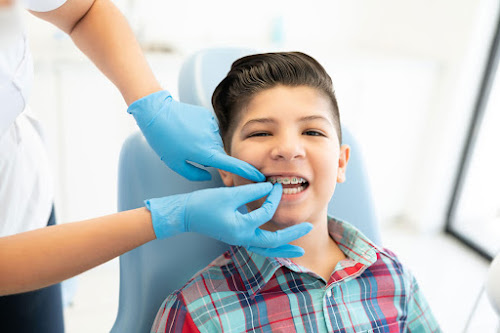Your smile is one of the first
things that people notice about you and for many people, an ideal smile is a
mouth full of pearly white, perfectly aligned teeth. It’s not a bad goal to
have, but in addition to straight white teeth, you need to make sure that your
smile is a healthy one.
Follow our tips below to make
sure your mouth and your smile are in tip top condition.
1. Brush your Teeth Twice a
Day, Every Day - You’ve been told this since
your very first dental visit as a child: brush your teeth twice a day. Brushing
removes leftover food particles that can bond with saliva to form plaque. These
particles feed the bacteria that naturally live in our mouths and these
bacteria can eat through our tooth enamel and cause tooth decay. When brushing
your teeth, be sure to use a quality electric toothbrush or a soft bristled
manual brush. While medium and hard bristled toothbrushes are readily
available, stiffer bristles and aggressive brushing causes gums to recede and
can wear down your tooth’s enamel.
Because plaque can harden into
tartar, frequent brushing helps your teeth stay whiter and healthier than in
people who brush less often. How you brush is important. Angle the bristles
toward the gumline at a 45-degree angle, with just enough pressure to make the
tissue a lighter color. Gently make small strokes, focusing on one or two teeth
at a time. Don’t apply too much pressure and invest in a good brush. And don’t
forget to brush your gums…this will keep your gums healthy and remove the most
plaque.
2. Use Fluoride Toothpaste - Fluoride helps strengthen
tooth enamel, making it an important additive to toothpaste. Using toothpaste and mouthwash with fluoride can reverse tooth decay at early stages, reducing
the need for fillings.
3. Keep your Tongue Clean - When you brush your teeth,
don’t forget to brush your tongue. Running your toothbrush over the white or
yellow area at the back of your tongue helps to remove the foul-smelling
bacterial waste that causes bad breath.
4. Take Good Care of your
Toothbrush - Your toothbrush doesn’t need
any special cleaning, but make sure it dries completely after each use and
there is no leftover toothpaste. Store your toothbrush in an upright position
that is exposed to air. Don’t forget to change out your old toothbrush for a
fresh new toothbrush every 3 to 4 months…or earlier if you see a lot of wear
and tear on the bristles.
5. Floss Every Night - Flossing is important because
it removes plaque between teeth and out from under the gumlines, where a
toothbrush can’t reach. If left alone, plaque and tartar build up under the
surface of the gumlines can cause periodontal disease, which leads to bone
destruction and tooth loss. Nightly flossing helps prevent tooth decay and
gingivitis.
To floss properly, wrap the
floss tightly around your finger and insert in the space between your teeth.
Gently slide it up and down under the gumlines two to three times. If bleeding
occurs, this is most likely due to gingivitis or gum disease. When flossing
daily, the bleeding associated with mild to moderate gingivitis usually stops
after about two weeks.
If you have braces or other
orthodontic appliances…try using a floss threader to help you floss between and
around each bracket.
6. Limit Sugary Drinks - The bacteria in our mouths
thrive on sugar which makes sugary drinks a major contributor to tooth decay.
Reducing the amount of sugar in your diet combined with regular brushing and
flossing can help keep the bacteria under control.
7. Maintain a Healthy Diet - A healthy diet is not only
important for your overall health, but it is important for your teeth as well.
In addition to good nutrition provided by healthy foods that help your bones
and teeth grow and stay healthy, a lot of fruits and vegetables are crunchy and
chewy, which promotes the production of saliva. Foods that require a lot of
chewing are good for the teeth because more saliva means the mouth is naturally
washed out more often.
8. Drink Plenty of Water - Water is the healthiest drink
for your smile and your body. Drinking water helps rinse teeth clean and
discourages tooth decay. Not only that…but keeping your body hydrated helps
your mouth produce enough saliva to keep your mouth and teeth clean. Saliva
naturally washes out the mouth, removing oral bacteria and the food particles
that they feed upon.
9. Don’t Chew on Hard Items - Don’t chew on hard candies or ice and keep non-food items like pens, pencils, and water bottle caps out of
your mouth. These items aren’t designed to be chewed and can damage your teeth.
10. See your Regular Dentist
Twice a Year - Regular dental visits are
necessary to preserving your oral health. Having routine cleanings every six
months helps to promote good oral health and a beautiful smile. Your dentist is
trained to recognize early signs of tooth decay and gum disease before they
cause severe damage to your teeth and mouth. Regular checkups are the key to
maintaining a healthy smile. Visiting your dentist twice a year can help you
avoid complicated and expensive dental procedures later in life. This is
important even though you may be seeing the orthodontist regularly. We will
point out any obvious problems, but we are not doing the thorough examination
with X-rays that your regular dentist is skilled at doing.
It can take some time before
you start to notice changes from improved oral hygiene. While these changes
won’t come overnight, they are certainly worth the time and effort, both for
the sake of your smile and your overall health.
With all the health advice
available online now, it’s hard to know what’s important to your oral health.
If you have any questions regarding the health of your teeth and mouth, don’t
hesitate to call our office.












